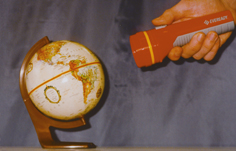|
Approach: One
to one |
| Focus:
Understanding the relationship
between the rotation of the earth relative to the sun and the time of day or night
for different locations on the earth. |
 |
840k |
Resources: globe,
torch, recording book |
|
Questions / instructions:
Here is a globe of the earth
and here is a torch.

Give students the globe
and point to New Zealand.
|
| |
|
%
responses
|
| |
|
|
Y8
|
1.
Imagine that it is 4 o'clock in the afternoon in New Zealand.
Where might the sun be?
Hold the torch and shine it from where you think the sun might
be. |
shining
on NZ from the west
|
38
|
|
Record
student response.
|
| 2.
It is daylight in New Zealand at the moment. Using the globe and the torch show
me what happens from 4 o'clock in the afternoon until midnight. |
globe
rotated so sun moves further west
|
42
|
|
rotated
quarter to half a turn
|
30
|
Put
torch aside. Point to New Zealand.
Imagine that it is the middle of the day in New Zealand.
Point to, and say FRANCE. |
a
|
a |
| 3.
Will it be daytime or night-time here? |
night
time
|
aa |
|
Record
student response.
|
90
|
|
Point to, and say AUSTRALIA |
|
a |
| 4.
Will it be daytime or night-time here? |
day
time
|
aa
|
|
Record
student response.
|
50
|
| Point
to, and say JAPAN. |
|
a |
| 5.
Will it be daytime or night-time here? |
day
time
|
a |
|
Record
student response.
|
38
|
Commentary:
Year 8 students demonstrated quite limited understanding of how the rotation of
the earth relative to the sun leads to patterns of night and day in different
locations on the earth. |